|
How to reach it
| • | On Games & Emulation Main Screen select a game, open the context menu (right click) and choose Edit Game (Single Edit Mode, see below) or select multiple games and choose Edit Multiple Games (Multi Edit Mode, see below) |
| • | In Rom Manager select a game, open the context menu (right click) and choose Edit Game (Single Edit Mode, see below) or select multiple games and choose Edit Multiple Games (Multi Edit Mode, see below) |
| • | In M.A.M.E. Configuration, when you import a category file (catlist.ini, nplayers.ini etc.) the Edit Game dialog is shown for each identified category (Category Edit Mode, see below) |
How it works
The Edit Game dialog lets you define the metadata for
| • | a single game (in Single Edit mode) |
| • | multiple games (in Multi Edit mode) |
| • | a game category (in Category Edit mode) |
Furthermore you are able to define a game-based default emulator as well as a J2K preset.
For platforms that support multiple volumes, you can define the files that should be considered as volumes in the Disks/Volumes tab.
For the PC-DOS platform you can define a game-based DOSBox configuration in the DOSBox Config tab as well as mount targets and executables in the Files/Directories tab.
Overview
The Edit Game dialog is divided into 4 areas:

Within the primary settings you define the primary meta data of the game and how it should be launched:
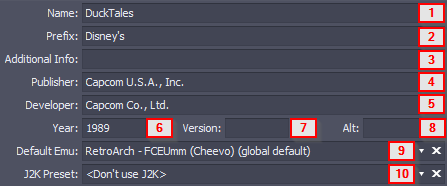
The game's name. It should be already set, either derived from the filename or from the MobyGame name (if it is linked to MobyGames release).
This content will be shown in the Name column of the Games and Emulation Main Screen's Main Table.
|
Prefixes to the game's name should be set here. "The", "A", "Disney's" are common candidates for prefixes which are also considered by the Add Game and Rescan processes in the Rom Manager.
This content will be shown preceeding the game's name in the Name column of the Games and Emulation Main Screen's Main Table.
|
Provide any additional info for the game. For example if the game has been modded, hacked or is a special edition, prototype etc. Many of them will already be considered by the Add Game and Rescan processs in the Rom Manager, see also: Tag Parser Settings.
The Additional Info will be shown after the game's name in brackets in the Name column of the Games and Emulation Main Screen's Main Table.
Example: Sonic the Hedgehog (The S Factor - Sonia and Silver, Hack by Aquaslash SHC2013)
|
If the game or romdump has information about it being an alternative version, this info belongs here.
The content will be shown in the Alt column of the Games and Emulation Main Screen's Main Table.
|
Select here, which emulator should be used to start this game when doubleclicked or by pressing Enter in the Games and Emulation Main Screen's Main Table.
The dropdown contains all emulators which support the platform of the game. See also: Emulator Settings.
|
If you're using J2K - A Joystick to Keyboard mapper (get it from www.emulation-evolved.net) you can define here, which preset should be used when launching the game.
|
|
Within the Genre Meta Data you can define which attributes the game provides regarding:
You can tick or untick the checkboxes of the attributes in order to re-define the game's meta data.
|
In the upper right corner are the following panels organized in tabs:
The Description tab allows a multi-line description of the game. The description is derived from the MobyGames meta data if the game has been linked to a MobyGames release.
The content will be shown in the Games and Emulation Main Screen's Summary area.
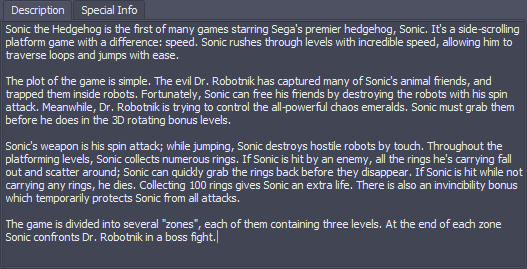
|
The Special Info tab allows a multi-line input of special information for the game's release. You can use this to provide information about a game hack, prototype, special edition etc.
The content will be shown in the Games and Emulation Main Screen's Special Summary area.

|
The Disks/Volumes tab is only shown when editing a game that belongs to a multi-volume platform (e.g. Commodore - C64, Sony - Playstation etc.). Here you get a list of files for the game.
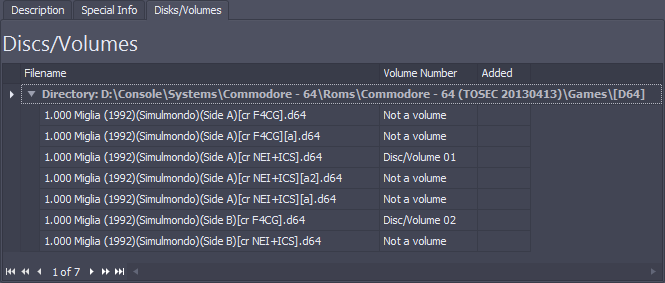
You can change the volume number by clicking inside the Volume Number cell.
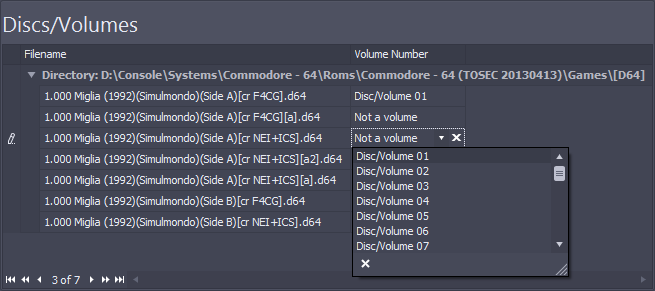
You should always ensure that you don't assign a volume number more than once. In the launch process, the first found media assigned to a volume number will be used:
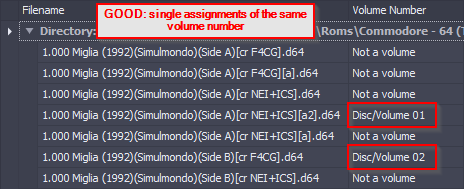 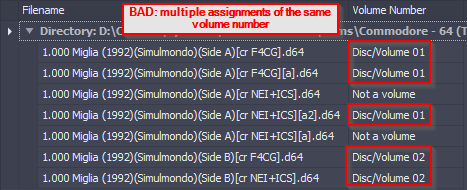
|
With the DOSBox Config tab, which is shown if you edit a game that belongs to the PC - DOS platform, you can set up game-specific DOSBox settings.
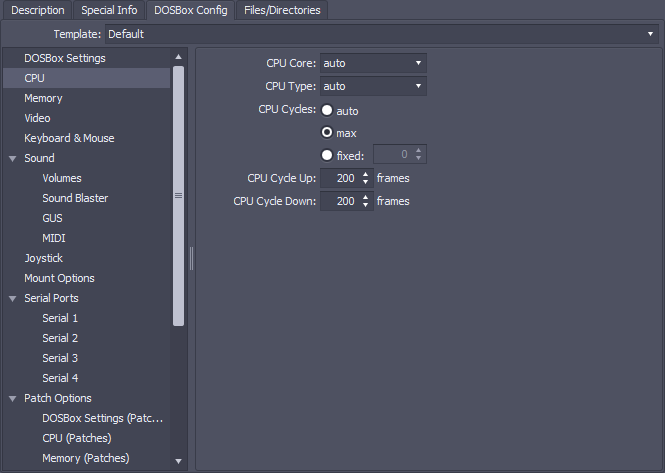
Every game's DOSBox settings are based on a template. You can change the template by using the dropdown on the top of the tab. Define your templates using the DOSBox Templates dialog.
The DOSBox Settings are organized in categories (list on the left) and configuration items (panel on the right).
If you alter a configuration item's value, the label will be displayed in bold. You can always check the original value (of the template), by hovering your mouse over the value's editor:
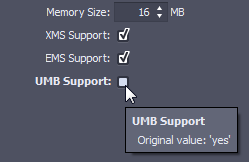
|
The Files/Directories tab is only shown if you edit a game belonging to the PC-DOS platform.
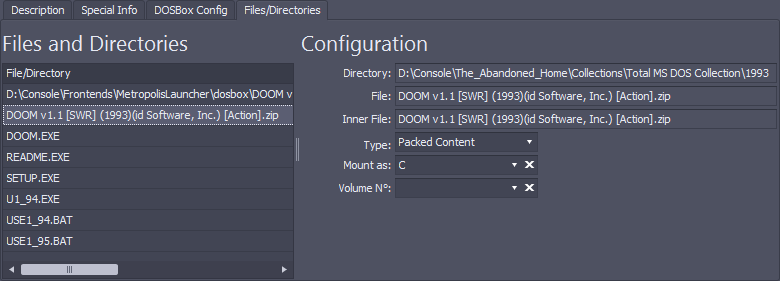
The list on the left shows relevant directories, executables and mountable files.
When you select an entry in this list, it's configuration is shown in the Configuration area. You can also edit the configuration there.
|
With the ScummVM Config tab, which is shown if you edit a game that belongs to the ScummVM multi-platform, you can set up game-specific ScummVM settings.

Every game's ScummVM settings are based on a template. You can change the template by using the dropdown on the top of the tab. Define your templates using the ScummVM Templates dialog.
The ScummVM Config is organized in categories (list on the left) and configuration items (panel on the right).
If you alter a configuration item's value, the label will be displayed in bold. You can always check the original value (of the template), by hovering your mouse over the value's editor:

|
|
In the lower left corner the following tabs are shown (see below). All data is editable with checkboxes, where checked items represent attributes supported by the game.
The TechInfo tab is organized in category groups. When expanded, the attributes can be viewed and edited by clicking the checkboxes.
All checked attributes will be shown in the Games & Emulation Main Screen's main list in multiple columns (Multiplayer Game Modes, Multiplayer Options, AgeO, AgeP) as well as the Technical Specs tab.
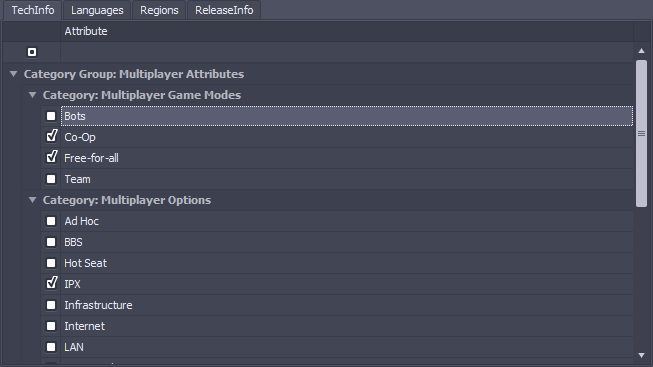
The TechInfo tab provides a context menu:

[i] Show Description
Use this menu item to get a description for the currently selected attribute:

[ii] Shoutcuts
This menu item provides a sub menu for different shortcuts. Each shortcut sets the checkbox of multiple attributes.
Example: The Sports Multiplayer shortcut, when chosen, will tick the individual checkboxes for Team, Bots, Free-for-All and Same/Splitscreen.
|
The Languages tab shows all possible languages. The languages supported by the game will have a checked checkbox. You can tick and untick each checkbox by clicking it.
All checked languages will be shown in the Games & Emulation Main Screen's main list in the Languages column. If no language is checked, the assumed supported language will be English and the Languages column will show (En).
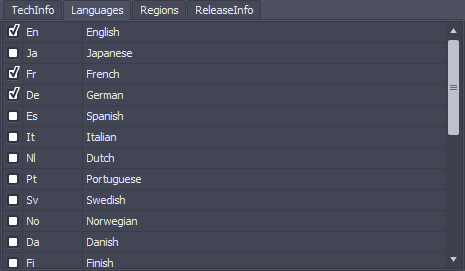
|
The Regions tab shows all possible regions. The regions supported by the game will have a checked checkbox. You can tick and untick each checkbox by clicking it.
All checked regions will be shown in the Games & Emulation Main Screen's main list in the Regions column.
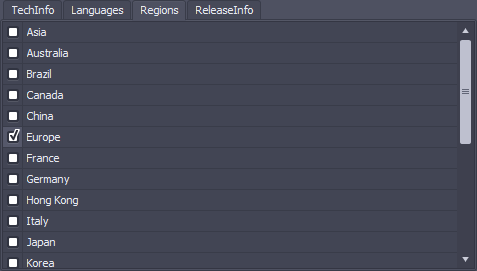
|
The ReleaseInfo tab show different attributes regarding the release. Tick or untick the checkboxes by clicking them.
All attributes are represented in the Games & Emulation Main Screen's main list with their individual column where cells can either be checked or unchecked.
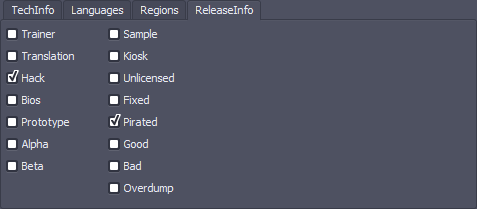
|
|
The Edit Game dialog is run in Single Edit Mode if you edit a single game (triggered by the Edit Game context menu item within the Games & Emulation Main Screen's main list or the Rom Manager).
The title of the dialog will be "Edit Game".
In Single Edit Mode
| • | any data already present for the game will be shown in the textboxes, dropdowns, checkboxes etc. |
| • | anything you edit will be applied to the one game you're editing |
|
The Edit Game dialog is run in the Multi Edit Mode if you edit multiple games (triggered by the Edit Multiple Games context menu item within the Games & Emulation Main Screen's main list or the Rom Manager).
The title of the dialog will be "Edit Multiple Games - Edit x Games" where x is the number of games you selected before choosing Edit Multiple Games.
In Multi Edit Mode
| • | all textboxes, dropdowns, checkboxes etc. will initially have empty values |
| • | values will be applied to all selected games in the following ways: |
textboxes: - empty text will not change the value
- entered text will overwrite
dropdowns: - "<do not change>" will not change the value
- any chosen value will overwrite
checkboxes: - in Multi Edit Mode all checkboxes incorporate three states: checked, unchecked, no value
- checked and unchecked states will overwrite
- "no value" will not change the value
|
The Category Edit Mode is similar to the Multi Edit Mode (see above).
The title of the dialog will be "Edit Multiple Games - LISTNAME.ini | CATEGORY NAME (NUMBER OF Roms)".
The Category Edit Mode is invoked, when you import an .ini file in the M.A.M.E. Configuration. For every category found in the .ini certain meta data may apply to the underlying games. Use the Edit Game dialog to define this meta data.
|
|





